Color Theory and Light
GA 91
2 August 1903, Berlin
Translated by Steiner Online Library
Lecture One
Theorem: Light seen through dark, appears yellow. Dark seen through light, appears blue. At the boundary between light and dark, colors appear.
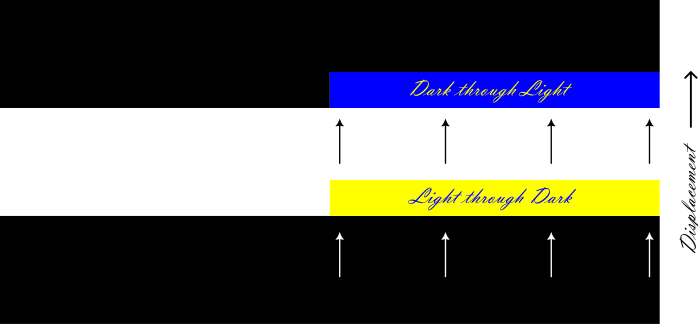
1. If you look at a black circle on a white field through a convex-cut glass, the circle enlarges, and around it you see a yellow border.
Also when the dark spreads into the light, yellow appears.
2. If you magnify a white circle on a dark field through a convex ground glass, you see a blue edge (Figure 2)
3. If you look at a white circle on a black field through a concave-cut glass, you see a reduced circle surrounded by a yellow rim.
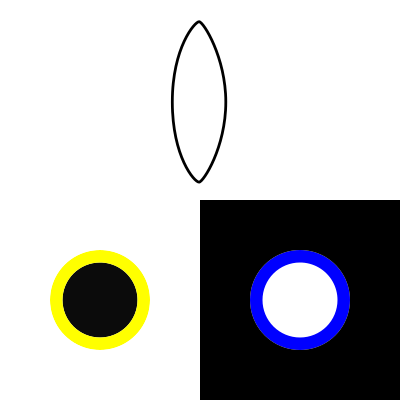
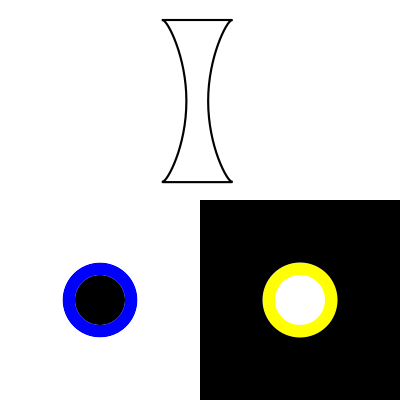
4. If you look at a black circle on a white background through a concave cut glass, you see it surrounded by a blue border, because as the white spreads into the dark, blue appears.
White and black are the two poles of light. Yellow and blue are the two poles of color. Green is the mixture of yellow and blue. (Gray is the mixture of white and black.) All other colors are shades.
Color is created by light and dark interacting at their boundaries without mixing. When they mix, white-gray or a hazy color is created.
If one looks at a black circle through a prism, the shape elongates and becomes an ellipse. Two edges are formed, one yellow and one blue; where it is narrow, the yellow edge is formed, where it is wide, the blue edge. In the other case the analogous event happens.
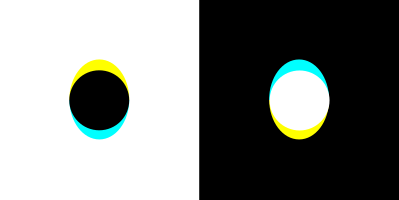
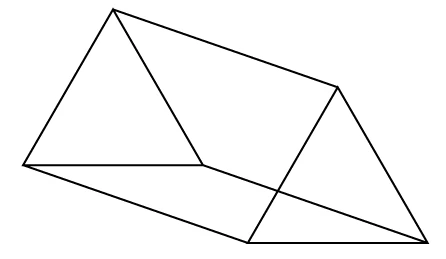
A white stripe, viewed through the prism, is shifted so that on one side light is passed over dark, on the other dark is passed over light; thus in the first case a blue edge stripe is formed, in the second a yellow one is formed.


If I take a wider prism, a red stripe joins the yellow one, and a violet one joins the blue one on the outside.
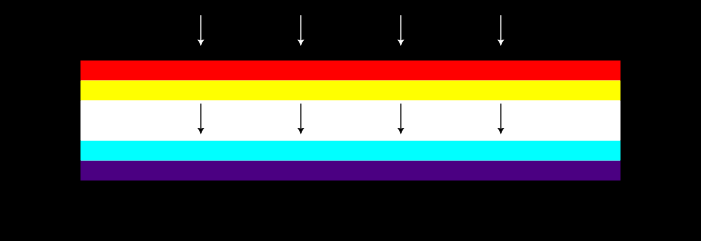
If the prism is still wider, orange still emerges in between on one side and indigo on the other.
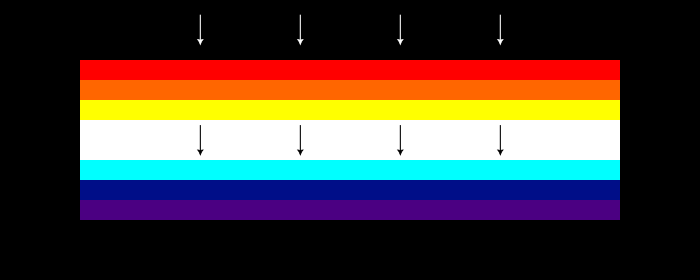
If the prism is of a width such that the two poles of color mix, the result is green.

All colors seen in such a way through a prism are subjective.
Now let's move on to objective colors—in a darkroom.
By letting the rays of light pass through a prism, we deflect the white circle formed on the screen, draw it out, and it acquires colored edges.
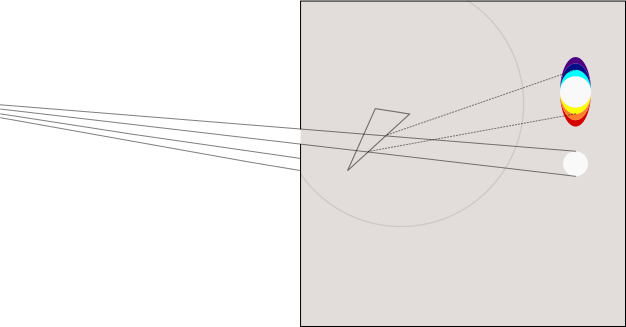
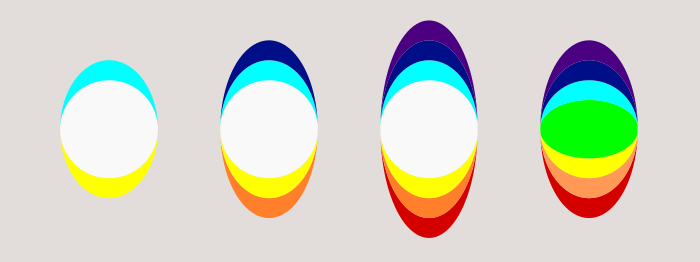
What was seen subjectively earlier emerges precisely in objective colors on the screen.
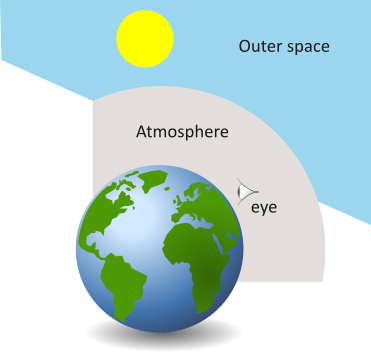
Zur Farben- und Lichtlehre I
Lehrsatz: Hell durch Dunkel gesehen, erscheint gelb. Dunkel durch Hell gesehen, erscheint blau. An der Grenze zwischen Hell und Dunkel entstehen die Farben.

1. Wenn man einen schwarzen Kreis auf einem weißen Feld durch ein konvex geschliffenes Glas [anschaut], so vergrößert sich der Kreis, und um ihn herum sieht man einen [gelben] Rand.
Also: Bei Ausbreitung des Dunklen ins Helle erscheint Gelb — siehe Lehrsatz.
2. Wenn man einen weißen Kreis auf dunklem Feld durch ein konvex geschliffenes Glas vergrößert, sieht man einen [blauen] Rand (Abb. S. 30).
3. Wenn man einen weißen Kreis auf schwarzem Grund durch ein konkav geschliffenes Glas betrachtet, dann sicht [man] den verkleinerten Kreis von einem gelben Rand umgeben - siehe Lehrsatz.


4. Wenn man einen schwarzen Kreis auf weißem Grund durch ein konkav geschliffenes Glas betrachtet, sieht man ihn von einem blauen Rand umgeben, denn bei der Ausbreitung des Weißen ins Dunkle erscheint Blau.
Weiß und Schwarz sind die beiden Lichtpole.
Gelb und Blau [sind] die beiden Farbenpole.
Grün ist die Mischung von Gelb und Blau.
(Grau ist die Mischung von Weiß und Schwarz.)
Alle anderen Farben sind Nuancen.
Die Farbe entsteht, indem Hell und Dunkel an ihren Grenzen zusammenwirken, ohne sich zu vermischen. Beim Vermischen entsteht Weißgrau oder Trüb.
Wenn ich den schwarzen Kreis durch ein Prisma ansehe, so verlängert sich die Form und wird zur Ellipse. Es entstehen zwei Ränder, ein gelber und [ein] blauer; da, wo es schmal ist, entsteht der gelbe, da, wo es breit ist, der blaue Rand. Im andern Falle - analog.


Ein weißer Streifen, durch das Prisma angesehen, wird verschoben, sodass auf der einen Seite Hell über Dunkel, auf der andern Dunkel über Hell geführt [wird]; also im ersten Fall ein blauer Randstreifen, im zweiten ein gelber entsteht.


Wenn ich ein breiteres Prisma nehme, tritt zum gelben Streifen ein roter, zum blauen ein violetter an der Außenseite hinzu.

Ist das Prisma noch [breiter], entstehen noch dazwischen auf der einen Seite Orange und auf der andern Indigo.

Ist das Prisma so breit, dass sich die beiden Farbenpole vermischen, entsteht Grün.

Alle auf eine solche Art durch ein Prisma gesehenen Farben sind subjektiv.
Gehen wir nun zu den objektiven [Farben] über - in einer Dunkelkammer.
Indem wir die Lichtstrahlen durch ein Prisma hindurchgehen lassen, lenken wir den auf dem Schirm gebildeten weißen Kreis ab, ziehen ihn in die Länge, und er erhält [farbige] Ränder.


Es entsteht genau in objektiven Farben auf dem Schirm, was früher subjektiv gesehen [worden] ist.


